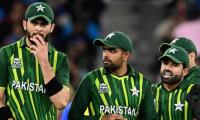Trouble in paradise may not be imminent, but inevitable. At the time of its inception, the Pakistan Democratic Movement posed to be a threat to the former hybrid regime, but strategic differences cast doubt over its efficacy six months down the line. Despite numerous setbacks and political theatrics, the alliance managed to oust the PTI government.
The dust is still settling. A so-called national government is already in place with a widely scattered cabinet. But each of these parties, except for the PTI, have political fault-lines along which they have historically contested against each other. The next six months will give clarity over the climate in Islamabad and whether these fault-lines will fracture abruptly or embolden, to organically disintegrate the alliance before the polls.
Ideas are already up in the air that a substantive level of seat adjustment and compromises within this coalition will come in effect for the impending elections, ensuring that all parties secure representation adequately in their respective constituencies and to make numbers that can keep Khan and the PTI at bay in the assemblies. But does that selective maneuvering within the political space bode well for democracy?
Alliances are a natural aspect of politics, but for the last three and a half years, the PTI government – despite having a stitched up bare minimum majority with its coalition partners – cultivated an environment of accountability hell bent on retribution and witch-hunts, forcing the opposition’s hand to unite. Now that the latter have ousted Khan, it’s only a matter of time that this coalition too will cleave. But how long will it last?
Differences already popped up recently when the interior minister was blamed by PPP leaders for a hawkish approach to the Madina incident, distancing themselves from any kind of political victimization of the opponents, especially one that is along religious lines. More such issues of differences will slowly surface as time goes by, since a number of smaller parties too form part of this arrangement.
However, the longer this coalition stays in effect, the longer each of these political parties will have trouble crafting their own respective positioning prior to the election. The current climate has very clear and two polar opposite narratives – there isn’t a third or fourth, unless a room is created for them to exist. It is very important for each of these parties to disengage from each other, develop their respective manifestos and populate the spectrum of political space in the country in their own right to foster a healthy competition. The cause and effect of this will be the eventual push back of the PTI’s polarized narrative in the run up to the polls. PTI intends to continue with this mood, with an all or nothing approach reflecting fascist undertones and bordering on abject disrespect of the constitution and any and all institutions that are against it.
Before the no-trust move, even the PML-N leadership along with the JUI-F wanted early polls, but settled for a compromise with the PPP and other coalition partners. Even now, a group within the PML-N is still calling for early elections, while the other along with the PPP insists on letting parliament complete its term and wants elections as per schedule. The latter is aiming to avert any political crisis, ensure stability, pass the budget and smoothly see off the next six months, at least till November, while legislating reforms, before priming up for elections.
This mostly suits the PPP also, because it has a government in Sindh that it intends will run its course. It is the only party that doesn’t have much to lose, and only a lot to potentially gain, through some smart politicking by co-chairman Asif Ali Zardari. While the party may appear to be striking a conciliatory note, it is a calculated risk where the benefits outweigh the losses. As so proudly pointed out by Asif Ali Zardari in an interview to Hamid Mir that he suggested the younger Sharif brother to be the prime minister post the no-trust motion. This was both a calculated move and a generous offer, but the former weighed in more than the latter. The PPP is part of the government led by Shehbaz Sharif, and directly shielded in case the current government fails to deliver on its promises. It will use its leverage for development funds for its MNAs, consolidate in southern and central Punjab and Khyber Pakhtunkhwa, and complete the Sindh government’s term – all to bide its time till the elections. It will not be a surprise if PPP ministers in the cabinet and those outside keep a low profile on the media as well.
Meanwhile, the PML-N, as the largest party, has the highest exposure and it will be critical for the party leadership to ascertain when to pull the plug, in case the current government is not able to turn the economy around. There are already a number of economic landmines that the PML-N has to diffuse while in power right now and there is a looming question mark over whether it’ll be able to sustain the same popularity it had in opposition, if they go ahead with the tough decisions they need to undertake. All this in the backdrop of growing unrest that Khan and his PTI threaten the government with. As a strategy, the PML-N is also countering the opposition with rallies of its own being led by Maryam Nawaz to stay prepared for this eventual outcome.
So will the current political dispensation do away earlier than expected or does it intend to linger on longer in the corridors of power. This in all its entirety could potentially be the reason for this coalition and the PDM to disintegrate, but whether these players consciously allow the PTI to capitalize on it is something that remains to be seen.
The writer is a political analyst based in Karachi.
Political instability has long plagued Pakistan, disrupting governance and economic planning
He was prolific writer and always expressed his views with clarity and firmness
In recent weeks, banks have searched for new borrowers, willing to take fresh debt at below-market rates
Pakistan’s constitution guarantees right to peaceful assembly – a cornerstone of democracy
Developing National WASH Account in Pakistan relies on range of stakeholders at federal, provincial, and district levels
Beauty of arbitration is that no conflicted party needs to sit at negotiating table and enter into dialogue with other...







